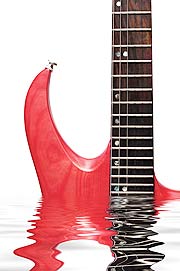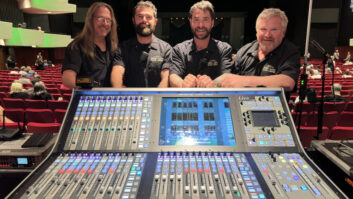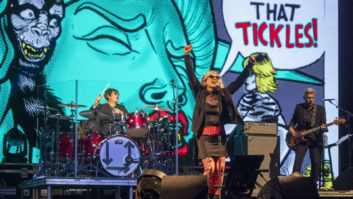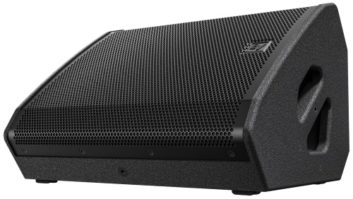
Since the dawn of amplified guitars, front-of-house engineers have grappled with players in a fierce battle for control over the mix — and nowhere is this more apparent than in the rock world. Usually the band soundchecks and the guitar player’s rig is at a reasonable volume. When show time comes, the guitar player kicks it up a few dB. By the end of the evening, the guitar rig is pumping out 105 dBs. If the engineer asks the player to turn it down, the invariable response is, “I can’t get my tone at a low volume.” In an effort to keep the vocals audible, the P.A. must be cranked up louder. Call me old school, but I’d like the whole thing at a lower level.
Obviously, others feel my pain, as technology brings options for amplifying guitar while keeping both engineer and guitarist happy. To find the best techniques for capturing rock guitars live, I turned to classic bands who have honed their performances over many, many years on the road — and the veteran engineers who make them sound great.
When engineer Mark Newman toured with Blondie in 2004, “They wanted a very quiet stage, so they used iso cabs for guitarists Chris Stein and Paul Carbonara,” he says. “Their amps were onstage [for easy access], and the cabinets were placed behind the drum riser. Each was a carpeted 18×18×40-inch custom cab and single 12-inch speaker, 1/4-inch input jack and XLR output on the side, with hinged lids allowing access to the speaker and mic. The speakers were mounted horizontally within the box, cone facing up. We stuffed the box lids with fiberfill to deaden them, as they didn’t like the ‘closed-box’ sound they were getting without the fill. I liked it better with the fill, as it added a kind of natural compression to the sound. We started with Shure KSM 32s inside the boxes, then changed to Beta 56s. We also added a Palmer PDI-09 DI in-line with the guitar signal path, just before it plugged into the speaker cabinet. I would then mix the two sources together to create the most killer guitar tone ever!”
Handling no less than seven input channels for one guitar rig is William Wellbaum (of Sound Image, San Diego, Calif.), the current house engineer for Pat Benatar. “Guitarist Neil Geraldo runs his rig in the 100-plus-dB range, so we have his two Marshalls pointed upstage to keep it manageable in the house,” says Wellbaum. “I use three stereo pairs: L/R Sennheiser 421s, L/R [Shure] SM57s, stereo outputs from a Line 6 POD, plus a beyerdynamic M88. These are all at different levels in the mix. The 57s provide the overall tone, the POD gives me the low-mid crunch and I kick up the 421s for Neil’s solos. The 421s and 57s are right at the grille, on-axis, with the 57s pointed close to the center of the speakers and the 421s pointed at the edge of the cone. The single M88 is placed back from the rig by a few feet, and I use it to capture the overall sound of the entire rig. Neil is a huge part of the band’s sound. His Marshalls are running an eight out of 10, and he is quite prominent in the mix.”
Don “Dodge” Dodger, currently out FOH mixing for Foreigner, agrees with the offstage cabinet philosophy: “We are totally on in-ears these days and don’t even have any amps onstage anymore. Mick Jones’ amp is in an iso box and I mike it with two Shure KSM 32s so I can split the pan out front hard L/R to keep it away from the lead vocal, which is up the middle. This gives a little more separation in the house. It may not be groundbreaking, but it works.”
Employing a variation of the offstage cabinet is Kansas’ production manager/FOH engineer Chad Singer. He uses a “fairly conventional” miking method on Rich Williams’ guitar rig, but the cabinet location is a little unusual. The entire guitar rig is on the floor directly in front of Williams except for the Peavey 4×12 stereo cabinet. “We try to place that cabinet as far away from the stage as possible, either in another room or offstage in guitar world, blowing away from the stage,” Singer says. “We cover the cab with thick drape to absorb as much sound as possible to separate a very loud guitar cab from the drum and vocal mics. I use two Heil PR-30 mics on the Peavey cabinet, slightly off the center of the speakers. I like the edgy, direct sound of the diaphragm, which helps separate the guitar in the mix from the warmer keys and bass.
“The entire band uses in-ear monitors without wedges or side-fills, and with no guitar cab onstage to provide that ambient sound, we ‘fake it’ in a number of ways,” Singer continues. “We have a couple ambient mics onstage. Rich gets the direct guitar mics, the ambient mics and the entire front-of-house mix for a little clarity. That keeps Rich from feeling like his head’s stuck to the side of the guitar cab, while at FOH I have a clean and direct guitar sound without a cab blasting onstage. The other electric guitar — played by our violinist Dave Ragsdale — is run through a Line 6 guitar POD, just using a mono DI without any guitar cabs.”
Yet not all guitar players are happy with an offstage cabinet. “For the guitar tone purists that want in-ears, putting the cabinet completely offstage just doesn’t work,” says Brian Bavido, FOH engineer for Ringo Starr & His All-Star Band. “I found that turning the cabinets around [so they don’t blast FOH or the audience] gives the players the ‘feel’ they want. If you take the cabinet completely offstage, the lack of air movement or vibration on the deck doesn’t thrill most players. Iso cabs simply don’t sound the same, they seem to choke the low end on the cabinet.
“I’ve also used Line 6 products at FOH,” Bavido continues. “I’ll take a clean guitar line out to me, put it in the POD and then play around with sounds a bit. This is never used as the ‘main’ sound, but it can be added to fill out the mix a bit. With the new Eleven simulator plug-in included on the Digidesign VENUE console, my world has opened up with tailoring sounds on a per-song basis. I’ve seen quite a few bands doing amp simulators only and it’s real slick. I would prefer a band to just use simulators alone and not even try using cabs.”
Engineer Brad Madix has worked with Shaker, Queensryche and Rush, and was introduced to the Palmer Speaker Simulator via Def Leppard in the early ’90s. “I was immediately convinced that this would be great along with the pair of 57s on the Marshalls, adding a little ‘direct’ sound to the great cabinet sound I had,” he says. “It’s remarkable what happens when you put two things side-by-side: I spent the next several weeks trying to get the 57s to sound as good as the Palmers! I finally scrapped the 57s. The direct signal always sounded better. The low end was tighter and the entire signal was clearer. The result was a significantly more usable and cohesive guitar sound, with no bleed from the monitors.
“After that initial direct-versus-57 experience, I had better luck with large-diaphragm mics like the [Audio-Technica] AT4050, but I always gravitated toward putting the mics offstage somewhere. The sound was just less ‘smeared.’ Queensryche — like many acts these days — puts a pair of single-12 cabinets in a pair of custom-made road cases, and we stuck the 4050s in there. There were no phase anomalies, no leakage from other sound sources and I didn’t have to smash the mic up against the grille. I could back it off a bit and capture a little more of the cone. They had a superclean-sounding stage. I’ve used a similar setup with Shakira over the past couple of years, though she has a few floor wedges scattered around the stage.
“Another reason to consider using a direct or offstage mic setup is the shenanigans onstage, which brings me to Marilyn Manson. The odds that a mic stand would get knocked over on his stage were about 2 in 5! It just made sense to do as many things as possible direct and skip the whole headache. Consistency is also a huge factor. There are only a few knobs on the Palmers. It’s hard to screw it up, and the Dis do the same thing every day. Any engineer who has spent any time fiddling with guitar mics knows that a fraction of an inch can entirely change the sound, especially when the mics are so close, as they need to be on an un-isolated guitar cabinet.”
Kurt Schlegel deals with some very unconventional guitar rigs. “When mixing house for The Melvins,” he explains, “there’s always lots of amp to mike and lots of tone to play with. Buzzo’s [King Buzzo, guitar for The Melvins] rig consists of a 4×12 and one or two single 15-inch speakers. The challenge is to make him even larger than life. For the 12-inch speakers, I use a pair of Shure KSM 32s on different speakers and pan the mics hard-left and -right. These mics have great body, top end that’s easy to work with and rarely require much in the way of EQ. On the 15-inch speaker, I use an Electro-Voice RE20 [sometimes a Sennheiser 421] on-axis and near the center of the cone to capture the lows and a really growly tone. This mic is panned center and run about 3 dB lower than the KSM 32s. All of these mics are placed pretty close to the grille and toward the edge of the dust cover, slightly off-center. The RE20 or 421 is on-axis to the speaker, but the KSM 32s are slightly off-axis. I’m careful about checking the phase of these mics because I am not combining the mics as a form of EQ. During the set, I raise the RE20 for solos or ride the groups of faders for the huge washes of guitar that Buzzo is nice enough to provide.”
Over the past year, Blue Öyster Cult has done some shows where we had the pleasure of supporting Kansas, and their setup sparked an idea that we now use for Donald “Buck Dharma” Roeser when we’re playing small rooms. Buck’s Steinberger feeds an X2 Digital Wireless, and the output of the X2 is connected directly into a rackmount effects device, typically an Alesis Quadraverb but sometimes a TC Electronic G-Major. The stereo outs of the effects device are patched into the effects returns of two 100-watt Marshall JCM900s, which drive one Marshall 4×12 cabinet switched for stereo operation. Needless to say, this rig can get kind of loud — and Buck likes it that way! In smaller rooms, this becomes a problem because the stage volume can overwhelm both the audience and the house P.A. system.
Our solution to this volume issue stems from what we saw Kansas doing with Rich [Williams’] guitar rig: We turn Buck’s 4×12 around so that the rear of the speaker cabinet faces the audience. This keeps the cabinet from blowing out into the audience and overpowering the room. Behind the cabinet (where the front now is), we place a pair of dynamic mics, preferably Audix D3s. I’ll start with the D3s at the center of the cone, move them an inch or two toward the rim of the dust cap, and then angle them about 30-degrees off-axis. This tames any high-frequency nasties; pointing any mic straight toward the center of the speaker cone usually results in a sound that’s too brittle for Buck. Buck then gets a bit of guitar in his monitor or in-ears to make up for the lack of stage sound. Problem solved.
In addition to being Mix’s sound reinforcement editor, Steve La Cerra is tour manager and FOH for Blue Öyster Cult.







